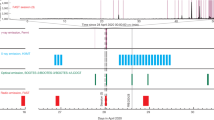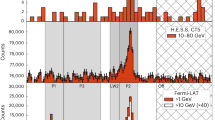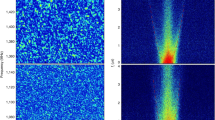Abstract
IF the pulsed radio source found near the Crab Nebula1 is a remnant of the supernova event of 1054, then the secular change in its period (assumed to be intrinsic to the source) reported by Richards2 can be used to estimate the age of typical longer period pulsars and hence the frequency with which pulsar-producing events occur in the galaxy.
This is a preview of subscription content, access via your institution
Access options
Subscribe to this journal
Receive 51 print issues and online access
$199.00 per year
only $3.90 per issue
Buy this article
- Purchase on SpringerLink
- Instant access to full article PDF
Prices may be subject to local taxes which are calculated during checkout
Similar content being viewed by others
References
Lovelace, R. V. E., Sutton, J. M., and Craft, H. D., IAU Circ. No. 2113 (1968).
Richards, D., IAU Circ. No. 2114 (1968).
Davies, J. G., Hunt, G. C., and Smith, F. G., Nature, 221, 27 (1969).
Cole, T. W., Nature, 221, 29 (1969).
Oort, J. H., Bull. Astro. Inst. Neth., 19, 239 (1967).
Allen, C. W., Astrophysical Quantities, 238 (The Athlone Press, London, 1963).
Large, M. I., Vaughan, A. E., and Bills, B. Y., Nature, 220, 340 (1968).
Guelin, M., Guibert, J., Huchtmeier, W., and Weliachew, L., Nature, 221, 249 (1969).
Trimble, V. L., A.J., 73, 535 (1968).
Author information
Authors and Affiliations
Rights and permissions
About this article
Cite this article
TRIMBLE, V. Frequency of Events producing Pulsars. Nature 221, 1038 (1969). https://doi.org/10.1038/2211038a0
Received:
Revised:
Issue date:
DOI: https://doi.org/10.1038/2211038a0
This article is cited by
-
Low-energy Cosmic Rays from Pulsar Flares?
Nature (1969)
-
Mass Loss from Pulsating Neutron Stars
Nature (1969)
-
Search for Nanosecond Optical Pulses from Crab Pulsar NP 0532
Nature (1969)
-
Pulsars as possible sources of superheavy nuclei in the primary cosmic radiation
Lettere al Nuovo Cimento (1969)



